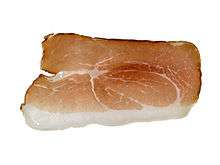Black Forest ham
Black Forest ham (German: Schwarzwälder Schinken) is a variety of dry-cured smoked ham produced in the Black Forest region of Germany.


In 1959, Hans Adler from Bonndorf pioneered manufacturing and selling Original Black Forest ham by retail and mail order.[1] Since 1997, the term "Black Forest ham" is a Protected Designation of Origin in the European Union, which means that any product sold in the EU as Black Forest ham must come from the Black Forest region in Germany. However, this appellation is not recognized in non-EU countries, particularly in Canada and the United States, where commercially produced hams of various types and quality are marketed and sold as Black Forest ham.
Preparation
Black Forest ham can take up to three months to produce.[2] Raw ham is salted and seasoned with garlic, coriander, pepper, juniper berries and other spices. After curing for two weeks, the salt is removed and the ham aged an additional two weeks. It is then cold-smoked using sawdust and fir or juniper brush at a temperature of not more than 25°C (77°F) for several weeks, becoming almost black on the outside and acquiring much of its distinctive flavor. It is then air-cured for at least two weeks before sale.
Characteristics
Black Forest ham is boneless and about one-fifth fat. It has a very pronounced flavor and is common in German cuisine. It may be eaten fresh, for example on holzofenbrot or rye bread or with fruit, or used as an ingredient in cooked dishes. Whole pieces of Black Forest ham can be preserved for months when stored properly. It is typically served at room temperature.[3]
Schwarzwälder Speck is bacon produced the same way and comes in two categories: Durchwachsener Speck has several layers of meat and half of it is fat; fetter Speck is almost completely fat. Both variants include the skin, called pork rind. The pork rind is too hard to eat, but it is cooked in some traditional German dishes like Linsen mit Spätzle or Eintopf to add its flavors to the food.
References
- Company history of Adler Schwarzwald
- "The production of Schwarzwälder Schinken Black Forest Ham" Archived 2011-01-12 at the Wayback Machine The Association of the Black Forest Ham Manufacturers Archived 2011-01-29 at the Wayback Machine (website). Accessed June 2010.
- http://www.schwarzwaelder-schinken-verband.de/index.php?seite=schinkenwissen Website of the Schwarzwälder-Schinken-Verband
External links
| Wikimedia Commons has media related to Black Forest ham. |